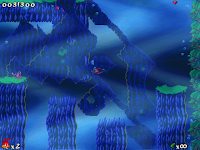 Author: [Dr]Dre@m
Author: [Dr]Dre@m
Year: 1998
Genre: Single Player
Filename: C_diam3d.j2l
Download: J2C, Mirror
This level is an old favourite of mine, and is probably one that most of you haven't played before. It's not perfect, and even has couple of serious flaws, but it also has a certain charm to it which I think is lacking in many other levels. Perhaps this is sentimentality speaking, but I think this level has a very unique style of design, and one that engages the player far more than most levels. And despite that, what it really all comes down to is the fact that Darn Mosquitoz is simply fun. That alone makes it worth playing.
The defining aspect of Darn Mosquitoz is the open-endedness. While there is a definitive path from beginning to end, there are so many branches along the way that the player must actually explore the level to complete it. There is a real sense of freedom and openness, and the whole thing feels more organic. On top of that, the level is loaded with secrets, making it more fun for those who enjoy exploring every nook and cranny. On top of the non-linear design, Darn Mosquitoz has a number of other design features that make it unique. Water plays a large role in the level, and is not set at a static height like in most other levels. Certain places will cause the water to rise up or go down, determining which areas of a room you can access. TNT is used in an interesting way, since the level has it in a limited supply and there are several areas where it is required to progress further in the level. Finally, the background and foreground layers are lined up with the level in a way that shows a high attention to detail, an example of this being certain places where the parallaxing foreground obscures secret areas.
On top of the non-linear design, Darn Mosquitoz has a number of other design features that make it unique. Water plays a large role in the level, and is not set at a static height like in most other levels. Certain places will cause the water to rise up or go down, determining which areas of a room you can access. TNT is used in an interesting way, since the level has it in a limited supply and there are several areas where it is required to progress further in the level. Finally, the background and foreground layers are lined up with the level in a way that shows a high attention to detail, an example of this being certain places where the parallaxing foreground obscures secret areas.
As I mentioned earlier, there are a few problems with this level. The first is that this level is very difficult, yet lacks a decent amount of checkpoints. Save often unless you want to be frustrated. Another problem is that the TNT, which is required to beat the level, is in a small and finite supply, so squandering it can render the level unbeatable. There is also one area with a fatal bug; a misplaced event that causes the level to stop scrolling. To avoid this, I suggest that you save the game when you see a text sign that says something along the lines of "You need perfect timing for this." The bug is a little ways after this area. Of lesser severity, there are also a few tile bugs in the level which, while ignorable, do tend to detract from the otherwise attractive use of the tileset. When I first played this level, it served as an inspiration for me when making my own levels. I don't know why it had such an impact on me, but even today I still find it fun to play though. It's flaws do prevent it from having the same sort of professional quality as some of the more famous level packs out there, but where Darn Mosquitoz lacks in professionalism it makes up for in sheer fun. And sometimes, that's all that matters.
When I first played this level, it served as an inspiration for me when making my own levels. I don't know why it had such an impact on me, but even today I still find it fun to play though. It's flaws do prevent it from having the same sort of professional quality as some of the more famous level packs out there, but where Darn Mosquitoz lacks in professionalism it makes up for in sheer fun. And sometimes, that's all that matters.
Good:
- Non-linear design
- A fun level to explore
- High difficulty level
- Unique tileset usage
- Lack of checkpoints makes saving necessary
- Fatal bug due to a misplaced "Limit X Scroll" event
- Can become unbeatable if TNT is wasted











